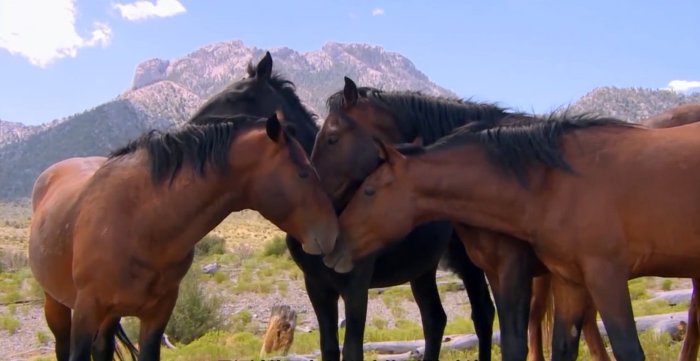What’s My Horse Saying? Interpreting Horse Sounds
Horses might not “talk” in words like we do, but their vocalizations are far from random. From soft sighs to loud neighs, each sound carries clues about their mood, needs, or even discomfort. Let’s break down the most common horse sounds—and what they’re really trying to tell you.

If you’ve ever heard your horse take a deep breath and slowly exhale through their mouth or nostrils, you’re listening to a sigh. Unlike their interactions with other horses, they do this a lot around humans—and the context says it all.
Relief sigh: Think of that “Aaaaah!” you let out when slipping off tight boots. Your horse might sigh this way during grooming or a massage, as tension melts from their muscles.
Relaxation sigh: Watch for this when you’re longeing or prepping to ride. They’ll drop their head forward and down, releasing a fluttering breath through their nostrils (sometimes more than once). Translation: “I’m calm now—let’s go.”
Boredom sigh: Ever sighed “ho-hum” while stuck in a long line? That’s your horse here. If ring work feels repetitive, their sigh is a nudge: Mix in new gymnastic exercises, flatwork patterns, or a trail ride to shake things up.
Groaning in horses is trickier—it could be harmless, or it might signal pain. The key is to play detective, especially if they’re new to you.
Habitual groaning: Some horses groan like humans clear their throats. For example, a horse might grunt over fences without a care—think of a tennis player who “oofs” with every serve.
Pain signals: If groaning comes with tense body language (pinned ears, rolling eyes, or tucking their hindquarters), investigate. It could mean:
Back issues (resisting saddling, hollowing their back when you mount).
Leg or foot pain (check for heat, or a resting stance that shifts weight off front feet—possible laminitis).
Internal discomfort (adhesions from past surgery, or ulcers—60% of performance horses get them!).
Rider-related groaning: If they groan only with certain riders, it might be a reaction to heavy landing after jumps or rough sitting trot.
Manure-time groaning: Usually harmless—just air moving as they bear down. But sudden groaning with straining and dry, firm manure? That could mean impaction. Check hydration (pinch neck skin—should spring back in 2 seconds), gut sounds, and gums. If anything seems off, call your vet.
Nickering is a soft, closed-lip sound—think of it as their version of a “hi!” Most often, it’s warm and welcoming: “You’re here! Let’s hang out!” Mares nicker to their foals this way, and your horse might nicker at you with pricked ears and an alert expression.
Excited anticipation: If your arrival means mealtime, the nicker might get quicker and higher-pitched: “Hurry up with the food!”
Anxious nickering: If they feel cornered or threatened, the nicker turns subdued, paired with fearful body language (pacing, flicking ears, rolling eyes). Step in to calm them—gentle grooming or quiet talk works wonders.
This is the sound of excitement: a quick inhale, then a loud, vibrating exhale through the nostrils. It’s their way of revving themselves (and others) up: “Something fun is happening!”
Turnout time? They might blow as you grab their lead rope: “We’re going out! We’re going out!”
On the trail, a stretch where you usually canter, or a cold breeze under their tail, could trigger it: “I want to move!”
Keep a steady hand if they keep blowing—head up, tail lifted—they might try to bolt, especially if friends are waiting to play. Pause for quiet halts or lead them in a small circle to refocus.
A neigh is hard to miss—it’s loud, and it means your horse is already stimulated. Tone and body language tell you if it’s anxious or confident.
Anxious neigh: High-pitched, tremulous, and paired with stress signals: pacing the fence, sweating, nervous defecation, flicking ears, or tucking their tail to look smaller. This is their cry for comfort—maybe they’re alone in turnout or missing a stablemate.
Confident neigh: Bold and bugle-like, with pricked ears, a lifted tail, and a steady gaze. At mealtime, it’s less a request, more a demand: “Feed me—now!” In a group, it might be a heads-up: “Strange horse approaching!” or “Check out that weird object!”
Horses might not be as “verbal” as humans, but they’re pros at linking sounds to meaning. Carriage horses learn complex voice commands tied to their names, and school horses? They’ll even anticipate a rider’s next move—before the instructor finishes saying it.
By tuning into their sighs, groans, nickers, blows, and neighs, you’re not just decoding sounds—you’re building a deeper bond. After all, understanding their “language” is the best way to let them know you’re listening.
Flow Hopehorse Equine get more horse/horse equine/horse product knows.